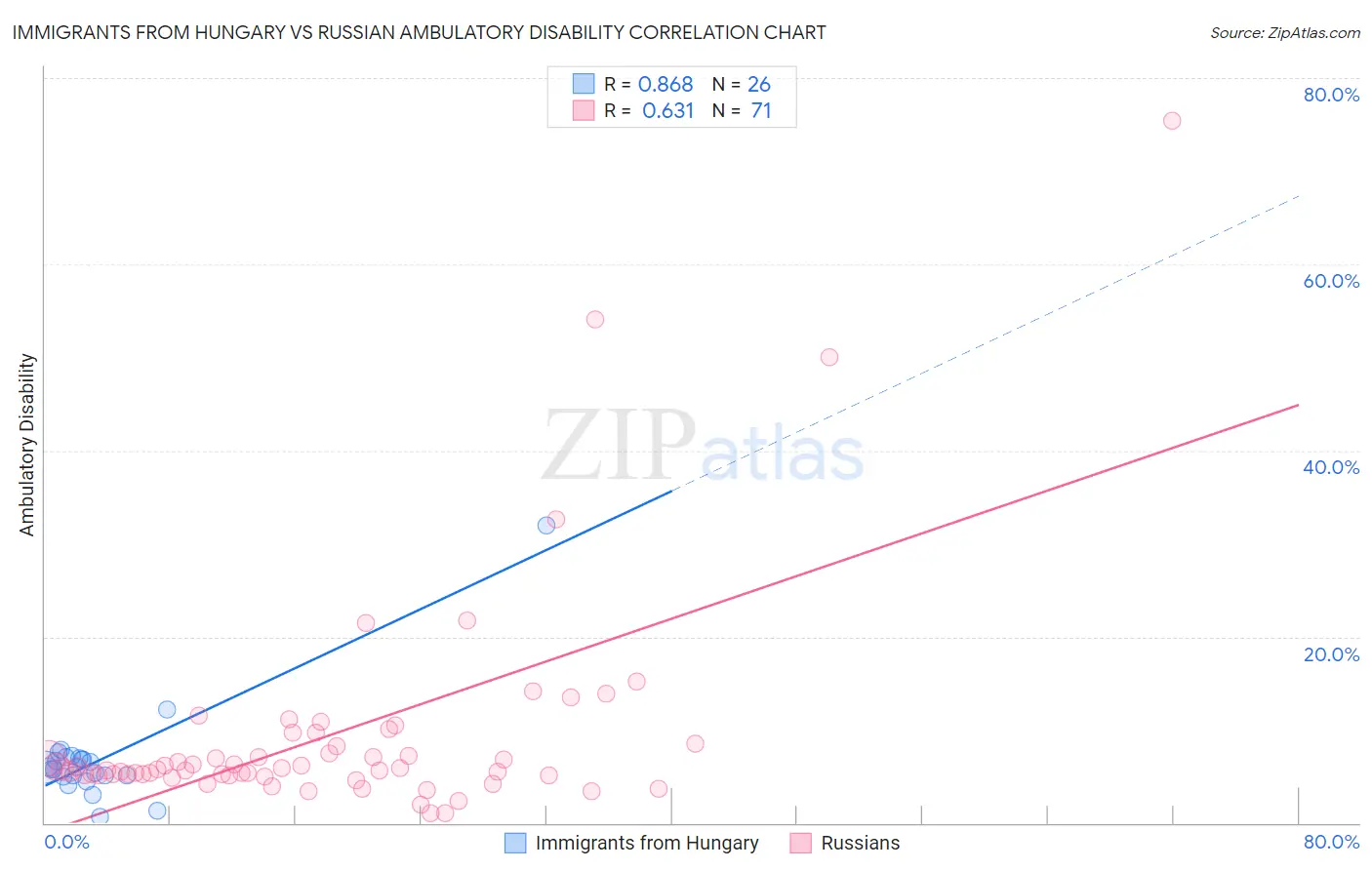Immigrants from Hungary vs Russian Ambulatory Disability
COMPARE
Immigrants from Hungary
Russian
Ambulatory Disability
Ambulatory Disability Comparison
Immigrants from Hungary
Russians
6.0%
AMBULATORY DISABILITY
83.9/ 100
METRIC RATING
138th/ 347
METRIC RANK
5.9%
AMBULATORY DISABILITY
93.4/ 100
METRIC RATING
118th/ 347
METRIC RANK
Immigrants from Hungary vs Russian Ambulatory Disability Correlation Chart
The statistical analysis conducted on geographies consisting of 195,671,605 people shows a very strong positive correlation between the proportion of Immigrants from Hungary and percentage of population with ambulatory disability in the United States with a correlation coefficient (R) of 0.868 and weighted average of 6.0%. Similarly, the statistical analysis conducted on geographies consisting of 511,917,360 people shows a significant positive correlation between the proportion of Russians and percentage of population with ambulatory disability in the United States with a correlation coefficient (R) of 0.631 and weighted average of 5.9%, a difference of 1.4%.

Ambulatory Disability Correlation Summary
| Measurement | Immigrants from Hungary | Russian |
| Minimum | 0.66% | 1.0% |
| Maximum | 32.0% | 75.4% |
| Range | 31.3% | 74.4% |
| Mean | 6.8% | 9.5% |
| Median | 6.0% | 5.8% |
| Interquartile 25% (IQ1) | 5.1% | 5.2% |
| Interquartile 75% (IQ3) | 7.0% | 8.5% |
| Interquartile Range (IQR) | 1.9% | 3.3% |
| Standard Deviation (Sample) | 5.6% | 11.9% |
| Standard Deviation (Population) | 5.5% | 11.9% |
Demographics Similar to Immigrants from Hungary and Russians by Ambulatory Disability
In terms of ambulatory disability, the demographic groups most similar to Immigrants from Hungary are Immigrants from North Macedonia (6.0%, a difference of 0.020%), Immigrants from Syria (6.0%, a difference of 0.020%), Immigrants from Italy (6.0%, a difference of 0.11%), Ute (6.0%, a difference of 0.29%), and Immigrants (6.0%, a difference of 0.33%). Similarly, the demographic groups most similar to Russians are Norwegian (5.9%, a difference of 0.080%), Estonian (5.9%, a difference of 0.11%), Costa Rican (5.9%, a difference of 0.18%), Icelander (5.9%, a difference of 0.18%), and Immigrants from Russia (5.9%, a difference of 0.21%).
| Demographics | Rating | Rank | Ambulatory Disability |
| Russians | 93.4 /100 | #118 | Exceptional 5.9% |
| Norwegians | 93.1 /100 | #119 | Exceptional 5.9% |
| Estonians | 92.9 /100 | #120 | Exceptional 5.9% |
| Costa Ricans | 92.6 /100 | #121 | Exceptional 5.9% |
| Icelanders | 92.6 /100 | #122 | Exceptional 5.9% |
| Immigrants | Russia | 92.4 /100 | #123 | Exceptional 5.9% |
| Immigrants | Middle Africa | 92.2 /100 | #124 | Exceptional 5.9% |
| Koreans | 91.6 /100 | #125 | Exceptional 5.9% |
| Arabs | 91.5 /100 | #126 | Exceptional 5.9% |
| Immigrants | Nigeria | 90.9 /100 | #127 | Exceptional 5.9% |
| Immigrants | Western Asia | 90.7 /100 | #128 | Exceptional 5.9% |
| Immigrants | Norway | 90.5 /100 | #129 | Exceptional 5.9% |
| Immigrants | Kazakhstan | 89.7 /100 | #130 | Excellent 5.9% |
| Immigrants | Costa Rica | 89.5 /100 | #131 | Excellent 5.9% |
| Immigrants | Europe | 87.8 /100 | #132 | Excellent 6.0% |
| Immigrants | Immigrants | 86.9 /100 | #133 | Excellent 6.0% |
| Ute | 86.6 /100 | #134 | Excellent 6.0% |
| Immigrants | Italy | 85.0 /100 | #135 | Excellent 6.0% |
| Immigrants | North Macedonia | 84.1 /100 | #136 | Excellent 6.0% |
| Immigrants | Syria | 84.1 /100 | #137 | Excellent 6.0% |
| Immigrants | Hungary | 83.9 /100 | #138 | Excellent 6.0% |